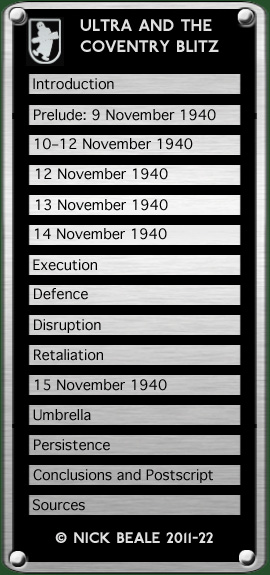|
During the night enemy air activity was lively. From 18.55 hrs. [GMT+2] around 150 aircraft approached the mainland … According to reports available so far bombs were dropped on 22 airfields and several decoy sites without any great effect. German Air Ministry Situation Report No. 436 The RAF plan foresaw the use of Bomber Command’s ”learner crews … on security patrols over easily identified enemy night bomber aerodromes”, Eindhoven, Schiphol and Soesterberg. It was suggested that “Jericho Gear” (whistles) should be attached to the bombs dropped on military targets in the German city selected for the Cold Water treatment. Whitleys assigned to Italian targets would still go there, weather permitting, as the opportunities for such attacks were expected to be few during the winter. Although the initial discussions had envisaged “cat's eye” Hurricanes patrolling the German beacon at Fécamp (where returning bombers switched on their navigation lights) and the use of Battles, Swordfish and Albacores against aerodromes near the coast, these ideas were not put into practice. Also dropped at an early stage was the idea of sending Blenheim night fighters on intruder missions to German bomber bases since that would have meant removing their onboard A.I. sets, whose exposure to the enemy could not be risked. Reinstalling the gear in the aircraft would have kept at least one squadron out of action “possibly for a number of days [which, the Prime Minister was advised] was not considered worthwhile.” The inference here is that no one relished the prospect of getting these temperamental early radar sets working again, once they had been disturbed.
Coastal Command Ofw. Wolff’s crew of 6./KG 2 was due to make two trips to Coventry. Their aircraft was bombed-up and ready to take off when a British bomber dropped three flares over the already moonlit airfield at St. Léger, 12 km. south of Arras. Bombs fell, the Flak opened up and men ran for shelter. There was a brief lull before the next attack and Wolff thought five or six passes were made in all but many of their bombs were directed at fires on a nearby decoy site and the Germans were able to fly their assigned mission. The RAF reported that eight Coastal Command Blenheims had been sent to St. Léger. One had returned with its load and one failed to find the aerodrome while the remainder dropped 32 bombs on the target without observing the results. The German summing-up was: “2215–2230 [GMT+2], St.-Léger-Süd, 5 x HE; attack on decoy site, no damage”. Eight Hudsons of No. 206 Squadron were dispatched, four apparently bringing their bombs home. The other four attacked the aerodromes at Roosendaal and Gravelines and the jetty at Calais. At Roosendaal a Bf 110 thought to be taking off to engage the bombers was claimed shot down. No. 59 Squadron (Blenheims) dropped 32 H.E. bombs and six incendiaries on KGr. 100’s base at Vannes. They reported some large fires and several small ones, plus bombs bursting on runways and dispersal areas. Soon afterward, Ultra was able to augment these assessments. Hauptmann Hoferer, base Kommandant, reported two attacks between 01.48 and 02.15, GMT; three from 02.47–03.17; and another from 03.42–03.48 hours. Three or four aircraft “of an unknown type” had bombed and machine-gunned the aerodrome and an 8.8 cm. Flak battery. None of the attackers had been brought down but the wireless station had been damaged and would be out of action from 22.30 GMT on the 15th. Another fragmentary report, thought probably to originate from Vannes, referred to eight or ten 50 kg. bombs being dropped of which one was an incendiary, four were delayed-action and two were duds. One man was slightly wounded and a Meteorological Post hut had burnt down. Telephone and other communications had been interrupted and in part destroyed, while two aircraft were damaged. The alert had sounded promptly and both light and heavy Flak had opened intense fire. From the day’s situation report: 01.00–07.50, Vannes, 20 x HE, numerous incendiaries, MG fire, phosphorus incendiary strips, dropped mostly outside the airfield; on the field barracks of men’s ward destroyed, two aircraft lightly damaged on ground, one soldier injured. No Coastal Command aircraft were lost on these operations. continued on next page …
|
||||

